How to minimise risks when carrying out renovation to a golf course
Related Articles
Golf course maintenance is essential every year. However, there are risks involved. Here, agronomist Noel Mackenzie details what they are and how they can be minimised – from detailing specific objectives regarding what the work must achieve to ensuring you aren’t in some sort of race to start topdressing as early in the year as possible.
Renovation essentially covers all the efforts to repair or mitigate the damage to playing surfaces caused by golfers and maintenance equipment on the course. However, renovation also may be used to restore surfaces after the effects of adverse weather conditions have harmed surfaces. Even if not harmed by weather or usage of the facilities, renovation is a means by which to improve surfaces whether they are fairway, green or tees. Renovation is the means by which we maintain or improve our sports surfaces by way of work that puts benefits into the surface.
So what are the benefits we put into the surfaces that we are renovating? The benefits should be determined by the challenges that face the club / greenkeeper. As my old gran used to mutter at me: “If a job is worth doing it is worth doing well”. So, if we are renovating we need to do it properly. To do it properly means we must understand what the problems are that we are facing because if we fail to do so we are, likely as not, wasting time and effort and will get sub-optimal results or possibly do more harm than good.
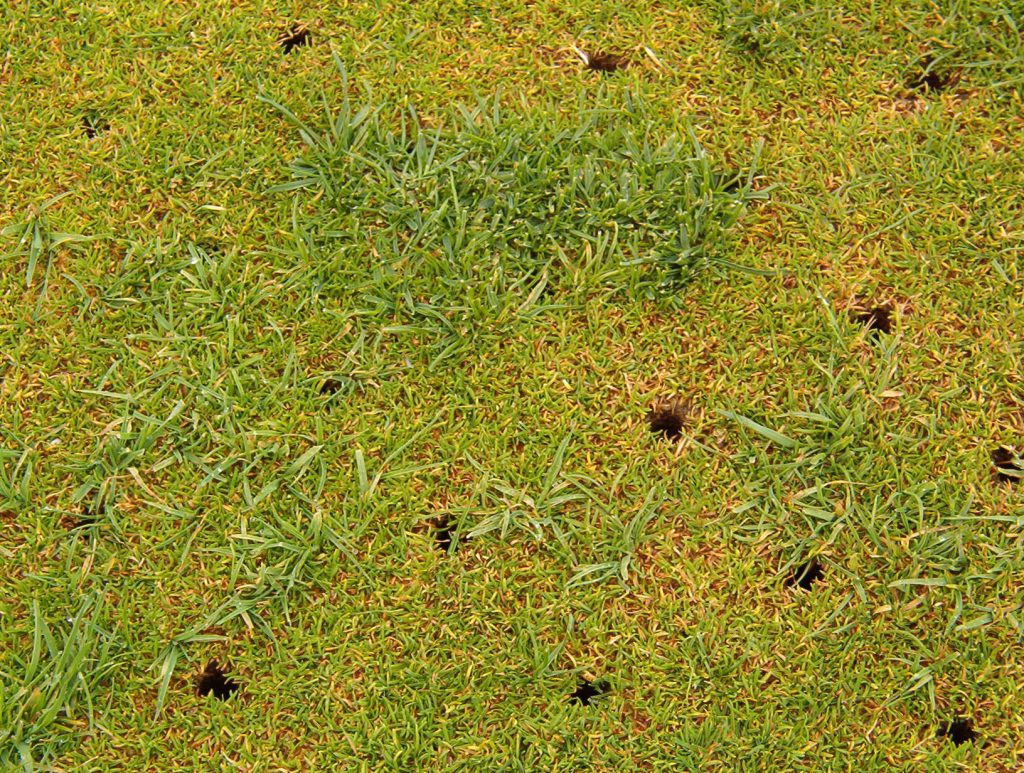
Determining the success of species in the sward has a lot to do with renovation practices
Assessment of the ‘patient’ is crucial to determining the right treatments to follow when renovating. Whilst it sounds pompous to say it I make no apology for doing so; I am constantly surprised how often I see greenkeepers carrying out work that is not optimal to their situation and how much money and effort is wasted. There are many reasons this occurs and, furthermore, can be due to the nature of the renovation work itself or the sequence of operations after the work is completed. One of the problems facing greenkeepers is that they are sometimes limited by factors:
Education – the technical knowledge to identify the challenges in front of them.
Experience – most greenkeepers in their lifetimes see only five or six courses at the most to work on them.
Specialist tools – occasionally identification of issues requires particular tools or even skill sets not available directly with the greenkeeper.
Budgets – the club simply hasn’t allocated or cannot allocate the monies necessary.
Calendar – the bookings on the course severely hinder course management, especially renovation, which impacts on the severity of work toleratated or the need to meet the demands of the next competition schedule bearing down immediately after ‘course maintenance week’ (assuming the club attempts to schedule such time aside for its key asset).
Asking around other greenkeepers on technically what to do on a renovation is not always a great plan as they may be limited themselves by experience or bring in ideas that might work on their particular situation, but not in others. For this reason, an independent agronomist should be your first ally in assessing the situation and assisting with the development of plans to address the issues being faced. They should also be able to take into account the costs of treatments and act as a support with the club or owner to justify the investments required. Yes, renovation is an investment! Furthermore, an experienced and technically qualified independent agronomist may bring experience of hundreds, possibly 1,000 or more, experiences to the assessment and planning development of your situation and yet have no pressure to sell products or materials as a sales representative might. What is not to like about that?
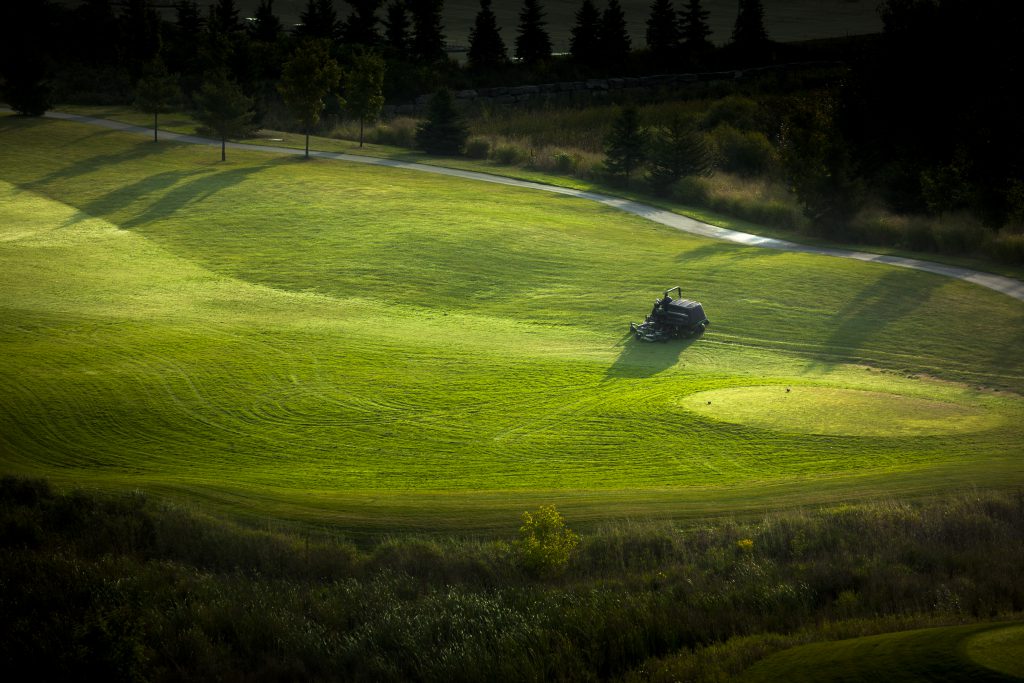
Objectives of renovation are not really considered very often in my experience. Vague notions of ‘removing thatch’, ‘smoothing the surface’, ‘introducing fescue’ or similar phrases are often banded about. Really the objectives should make a logical progression from observation / measurement and player feedback. The overall course mission should be to maintain or improve surfaces, but when it comes to renovation outcomes these should be more specific, possibly even measurable. Say the greens are ‘bobbly’ (vertical ball deviation) and unpredictable, it is possible to measure this with a Parrymeter or Trueness meter or you can assess the results by attributing qualitative values derived from visual analysis of ball roll. Assessment of ‘snaking’ (lateral ball deviation from a straight line) can also be assessed. The objective can therefore be stated as ‘aiming to reduce ball deviation average from 18cm to 10cm’ or ’reducing ball bobble from a score of 8/10 to 3/10 on a qualitative scale’ these translate into improving greens’ smoothness and trueness with smarter objectives to allow review and progress measurement.
Another common example might be to improve soil organic matter values and here the testing is useful in setting goals. The key thing is to ensure the testing is as consistent as possible and to be cautious in the goals that are set. If the green’s organic matter is, say 5.5 per cent in the top 0-20mm, it’s not likely to drop to a more desirable two per cent in one season of renovations. If the club has concerns over soft greens and is looking to see improvement, managing expectation is important.
Renovation calls on all manner of tools for us to achieve certain objectives and essentially all renovation should enable the surface to stay in play – otherwise it is known as a construction project! In general terms renovation focuses around a few key core operations, these being:
Verticutting
Scarifying
Aeration
Overseeding
Topdressing.
It looks so simple doesn’t it? How do we decide if we should verticut or scarify? Which aeration type should be used? And at what depth? Should we seed or not? If we do, what with? Which species, cultivars, seed treatments? Should we topdress with sand or a blend of sand and soil / peat / green compost / soil amendments and so on. The list of questions is not quite infinite but if done properly it almost feels like it!
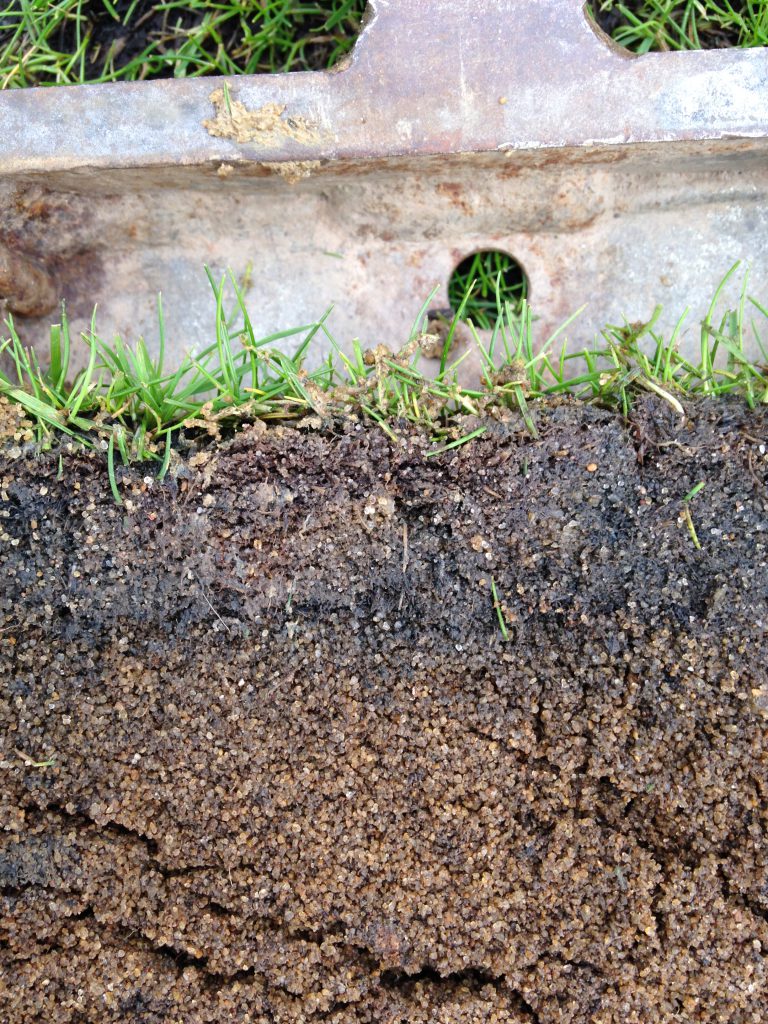
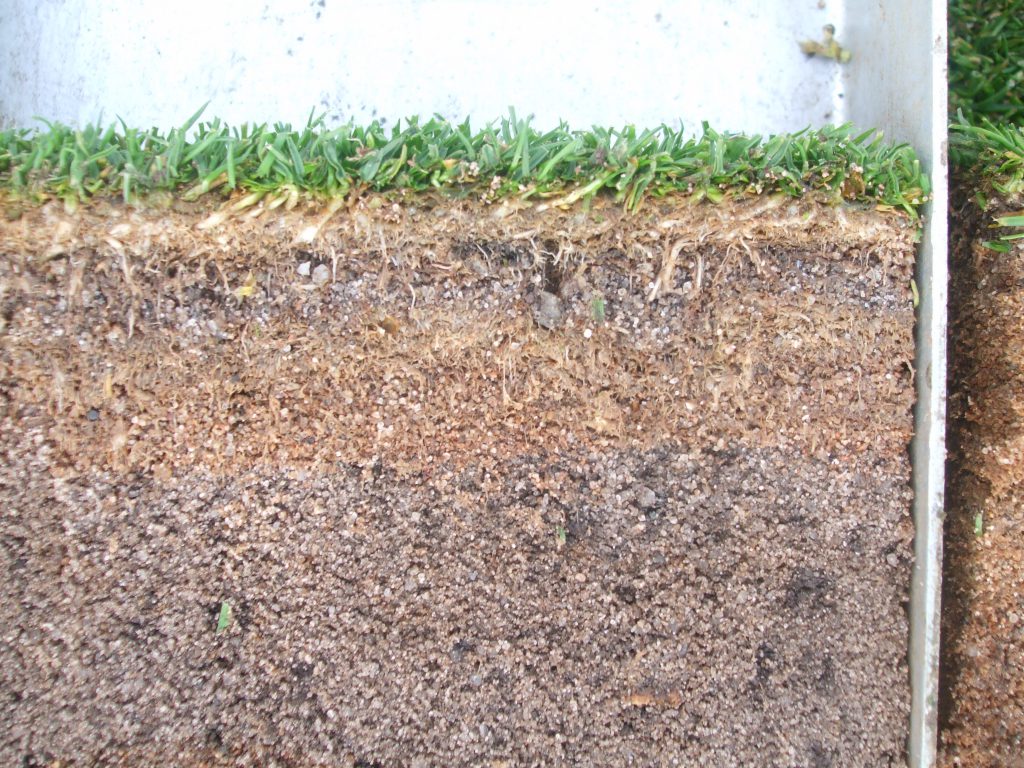
Different soil profiles require different solutions
Yet time and again I see people going through the motions, making the same efforts and yet not really stopping to question ‘why’? Are their sought outcomes appropriate? Should what they started doing seven years ago when they had a problem with something still be done now or replaced with another action? The problem is even worse when it comes to renovating large areas like fairways, and these large areas are urgently in need of attention on many golf courses following the drought of last year – yet still I see people doing the same thing – a tickle of aeration, throw some cheap ryegrass seed at it (cheap for a reason), fertiliser application… and wait for the results. And wait … and wait…
When should we carry out renovation? Well that is a $64 million dollar question! Much depends on geographical location, up north or up a mountain and it will be later than a south coast sun spot … so using a soil thermometer is quite handy to give a guide as is using growing degree days. As well as location, the surface’s needs and outcomes that are being sought from completing renovation will also determine when it should be completed. For example, the last few years have seen topdressing work commencing earlier and earlier in the season like it’s a race between greenkeepers as to who can get their dressing on first … it’s not a race!
Topdressing can go on at almost any time and the amount needs to be very small if conditions for growth are poor due to cold temperatures as the grass needs to grow through the dressing material. Often problems arise even when the dressing is applied correctly and the right material is used because the commencement of topdressing is applied with other treatments that are not appropriate for the colder conditions. The classic example is hollow tine work in early spring around Easter time when easterly winds dry surfaces and stress the edges of the tine holes, especially large ones. Following on from this, tine hole recovery is slow and the greens ‘speckle’ from the pattern of holes in the turf / soil. These holes then remain visible for months, sometimes right through the playing season into winter and furthermore reduce playing surface quality. Optimal choices are therefore important to consider.
Greens’ renovation and fighting the tide of annual meadow grass (Poa annua) is a complex area. On the one hand opening up the surface allows annual meadow grass seed to germinate and establish, but without doing that, introduced seed does not stand a chance to germinate or establish. Very careful thought has to be put into what you are trying to achieve with which species and cultivars and when you are introducing them. Furthermore, the aftercare is also crucially important. But what if you only want meadow grass? Well simple really … feed plenty, water plenty and cut nice and close to your heart’s content, then institute a disease control programme spraying fungicide on a three-to-four week basis from August onwards (and lots of iron) and there is still a need to scarify and verticut. However, if the plan is more resilient greens or surfaces, a more considered approach will be needed to successfully integrate a mix of species into the turf.
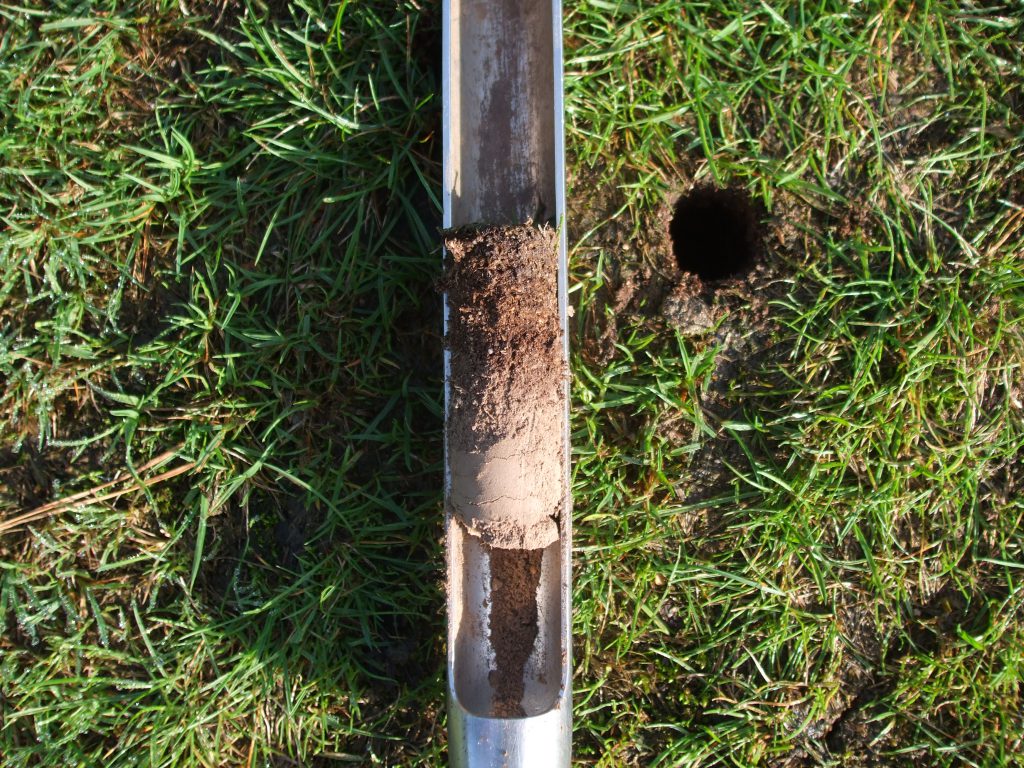
Fairway renovation is seldom give the attention it deserves – hence why so many courses got a wake-up call in 2018
This early spring I gave a talk at the BIGGA SW section on the importance of renovating fairways. Fairways in the south of the UK took a real pounding in dry and bright spring conditions that prevailed last year and many fairways ‘burnt up’ badly and recovered very poorly indeed. With seed in short supply this year due to poor harvests under drought last year, things are going to be more expensive to put right. Many golf courses wont put it right unfortunately, they will simply struggle with fairways that ‘burn-off’ again as the annual meadow grass that filled in last year after the drought fails again under a fresh drought in 2019. I fear this spring will be as bad as last year and certainly it seems to have been a dry winter and the soils in the fields are already dry this year, prompting concerns from farmers. Renovation on fairways tends to be a problem area because clubs are not really geared up for treating such large areas when they fail or become weak and not many have fairway irrigations to aid seedling establishment. Furthermore, with tight budgets on many courses due to oversupply of golfers or silly price wars, forcing income and, therefore, budgets down, the situation is made ever more difficult for the greenkeeper. Renovation costs money and sometimes compromises need to be made. That said, if the compromise leads to a failure to get a good result then the economy is a foolhardy one and harms the course more than benefiting it … and certainly harms the greenkeeper’s reputation and respect from the club and its members. Cutting costs causing cutting corners is a shortcut to failure.
Renovation is an essential element of maintaining golf courses and helps to reduce lost play, lost income and improve player experience – all of which help to keep players happy and returning which is the key exercise in running the business.
Investing in good renovation is investing in course improvement (so long as fundamental construction is sound) and every effort should be made to optimise the results and the works to get the best results and minimise golfer inconvenience as much as possible. The key questions remain:
Why renovation is done
What operations are done
Where it is done
When it is done?
How it is done?
How many of us really address these questions with the due diligence we should, is another key question!
Noel Mackenzie is a member of GreenKeeping’s editorial advisory panel and is the principal consultant at Sports Turf Consulting. Tel: 07739 505862 or email info@sportsturfconsulting.co.uk

























